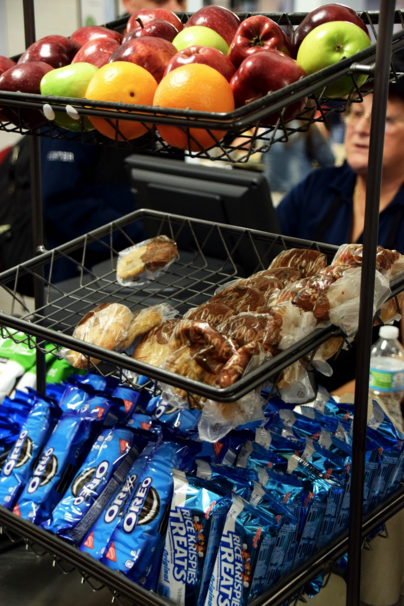The pros and cons of stocking unhealthy snacks in the cafeteria
The Staples Cafeteria is a place to talk, see friends, and most importantly, grab something to eat. And yet among the multitude of lunch choices, “The Caf” has been known to feature many foods, like massive cupcakes and piles of fries, that are aren’t exactly healthy choices in an era of skyrocketing obesity and diet-related diseases. But would “the Caf” be better off without them? Here, we weigh the pros and cons of allowing some junk in the cafeteria.
Let’s get rid of unhealthy food
“The Caf” at Staples does a pretty remarkable job when it comes to offering a multitude of food options. A quick look around reveals a seemingly endless variety of snacks, drinks, and complete meals–from panini to sushi. Sounds great, right?
Wrong.
Upon closer inspection, you find that the lunchroom serves items more akin to a candy store than a school cafeteria. Lining the check-out aisles are shelves full of Rice Krispies, cupcakes, cookies, and, to top it off, there’s a fro-yo machine in the corner, just begging to be used.
I’m not saying that Staples students don’t deserve a treat, they absolutely do. For teens who spend hours toiling away in AP classes, an occasional sweet is a welcome reward. But how much of a good thing is too much?
Having the most unhealthy foods right next to where you pay is clever. As you line up with your sandwich, pizza, salad, or any kind of meal, the colorful wrappers and in-your-face placement of sugar-laden sweets is the ultimate advertising trick, picked up from the grocery and fast-food industries. It spurs impulse buys — last minute-purchases of a cookie or Rice Krispie Treat that you don’t necessarily need, you just feel compelled to get.
It’s this kind of mentality that’s a slippery slope. Cupcakes aren’t inherently bad, but the near daily consumption of a half-pound hunk of cake slathered with sugary frosting can have negative implications for your body, not the least of which is a major sugar crash that leaves you feeling tired and depleted. In a nation where nearly a third of adults suffer from obesity and other dietary-linked diseases, it’s now more important than ever to pay attention to what we are scarfing down, if only to make sure we’re not unknowingly feeding the beast and creating a sugar addiction.
Once again, demonizing sweets will get us nowhere. Displaying nutritional data on some of the à la carte items could go a long way to swaying students’ minds. We need to focus on putting the emphasis on eating healthier, so, in the end, it’s all about awareness and moderation.
Keep the Sweets
Sure, the Staples cafeteria offers many unhealthy options. But look at Westport, a town full of some of the smartest kids in the nation and home to some of the most amazing athletes.
These students are smart enough to decide when enough is enough. Students enrolled classes such as Multivariable Calculus BC, AP Lang, and AP Gov will be able to determine when they need to eat some healthy food. They understand that they can’t eat Oreos, fries, and a smoothie for lunch every single day.
The student-athletes know that they will not be ready for a game or a meet after eating only a massive cupcake for lunch. They know that food is fuel, and they understand how their intake will affect their performance, and they tailor their diets for their activities.
Staples athletes aren’t the only ones who fit in physical activity during the week. Many students will go to the gym two or three times a week to stay in shape. This exercise will help prevent them from becoming overweight and will keep them healthy, despite consuming some junk during the week.
At the end of the day, it’s all about choices.
The Staples cafeteria doesn’t only offer cookies, chips, and fro yo, it offers many healthy choices to balance out the sweets. It has salad bars, fruit stands, protein bars, and healthy sandwiches. With a little balance, a few treats a week won’t kill you.
Finally, to break up the monotony of the school day, there’s something exciting about having the cafeteria bring in new items. When we hear that there is now a frozen yogurt bar or a sushi bar in the cafeteria, they get psyched, and rush down to try the new thing. Lunch is one of the parts of the day that almost all students look forward to, and there’s something novel about being able to try something new at lunchtime.
The cafeteria, like most of the local delis and venues we visit, will always have some form of unhealthy food for sale. After all, a wide selection produces many more customers, and as a result, brings in higher revenues. So why not offer students a choice? If they decide they deserve an occasional basket of fries or an ice cream, then they are entitled to have it.
High school is all about choices, and students can decide for themselves if they should spoil themselves with a gigantic cupcake, or if it is time to settle for a fresh apple.


















































